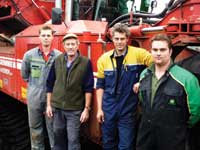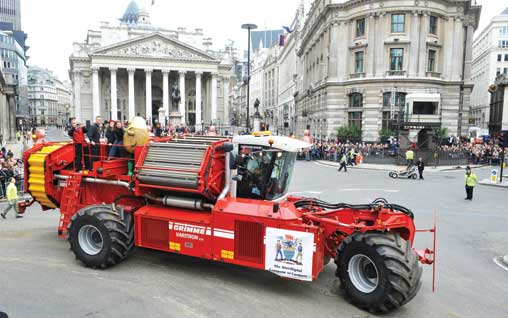VIDEO: Potato harvester at Lord Mayor’s Show

It’s not every day a potato harvester trundles through the streets of London. But a two-row self-propelled machine weighing more than 20 tonnes did just that earlier this month when it took part in the Lord Mayor’s Show.
Bringing a real taste of the English countryside to one of London’s biggest street parades was made possible by Cambridgeshire grower Richard Lee, who farms with his two sons, Andrew and Christopher, just outside Ely.
“Everyone has heard of Jersey Royal potatoes,” explains Christopher, after the family agreed to send one of its harvesters to London. “We just wanted to get the Cambridgeshire fenland potato on the map and get us noticed.”
Highflyer Farms produces about 37,500 tonnes of potatoes every year. It’s a big operation. Most are sold wholesale and served up in fish and chip shops the length and breadth of Britain. Others are exported to Ireland.
All Highflyer potatoes are harvested using Grimme machines, including the flagship Varitron 270, which boasts a 6ft flotation wheel on the front, a caterpillar track almost one metre wide on the left-hand side and a 7t holding tank.
Farmworker Wayne Harlock admits to being a little nervous about driving such a big piece of kit through London. Every year, some 300,000 people line the streets to watch the Lord Mayor’s Show. Millions more watch on television.
“At the minute, I’m a little bit worried,” he told Farmers Weekly a month before the event. “I hope it goes OK, but I’ve only ever driven a car around London once – nothing as big as this.”
The three-mile route takes in some of London’s most famous landmarks, including St Paul’s Cathedral. It passes along Fleet Street and Ludgate Hill before ending up at Aldwych, at the end of the Strand.
After being spruced up and leaving the farm, the journey to London started outside Ely Cathedral, where the harvester was waved off by the Bishop of Huntingdon, the Dean of Ely Cathedral and some early morning onlookers.
It was a close-run thing. Just days before, following heavy rain, the harvester hit a particularly soft spot in the black fenland fields and sank into the spongy soil, bending almost all the panels on one side of the machine.

Grimme engineers worked around the clock to get it up and running again, ordering new panels and making sure the Varitron was good as new. When the big day arrived, no-one would have known the difference.
“We could have done the parade with a demonstration machine, but we thought it would be more realistic to use a farmer’s machine that had actually be working in the fields,” says Barry Baker of Grimme Agriculture.
On reaching the outskirts of Ely, the harvester was driven on to a low-loader before starting on the 80-mile journey south, entering London to be greeted by Lindsay Hargreaves, liveryman of the Worshipful Company of Farmers.
The WCF has taken part in the Lord Mayor’s Show for the last five years, its members walking ahead of various machines including a combine harvester, forage harvester, pea viner and a 10-furrow plough.
This year, it was the turn of WCF master Follet Balch, senior warden Peter Faulkner and junior warden John Reynolds to accompany Mr Hargreaves from Mansion House to the Royal Courts of Justice and back again.
“In many respects, bringing a potato harvester to London is a bit of fun,” says Mr Hargreaves. “But there is a serious point to it, because we’re trying to bring together some of the different aspects of agriculture and the City of London.
“Many people in London are unaware of what agriculture involves and where their food comes from. Equally, out in the sticks, we’re not always aware of how important City people are to what we do.
“Taking a shiny piece of the countryside to London brings a smile to people’s faces and it gets them talking. It all helps to drive the farming message home, building stronger links between farmers and their customers.”
The day of the show dawned warm and dry for November. Crowds lined the three-mile route as the harvester snaked its way through the streets, with pictures of the machine making it onto national television.
An hour-long break after reaching the Royal Courts of Justice enabled everyone to grab a sandwich and take a well-earned rest before the harvester was driven back to Mansion House by Wayne’s colleague farmworker, Nick Rolffe.
So how did the two drivers get on driving such a big machine through the middle of London?
“There were one or two tight corners, but I didn’t clip any wing mirrors,” says Wayne. And would they do it again? “Definitely.”
About the Lord Mayor’s Show
The 2010 Lord Mayor’s Show was one of the biggest-ever, bringing together Zulu warriors, sultry samba dancers and the best of London pageantry.
This was the show’s 785th year. There has been a Lord Mayor of London ever since 1189. In 1215, by charter of King John, it became one of the earliest elected offices in Britain.
The king’s charter allowed the people of London to elect their own Lord Mayor every year. In return, the king required that the new mayor presented himself to the sovereign and showed that he had the support of the people.
Each year, the newly elected Lord Mayor – currently Michael Bear and not Boris Johnson, who is (confusingly) the simply the “mayor of London” – made the long journey up river from the City to Westminster to pledge allegiance. The procession has taken place for 785 years, surviving plague, fire, war and insurrection.
The modern Lord Mayor’s Show is still a direct descendant of that first procession, but the journey now takes place on land, snaking its way through the City streets every November.
Participants include livery companies, charities, the armed forces, the City Police and Londoners from all walks of life. Some 300,000 people turn out each year to watch the parade, and a further 2m people watch on television worldwide.
THE WORSHIPFUL COMPANY OF FARMERS Many of the London guilds have histories that stretch back centuries. But the Worshipful Company of Farmers is a much later organisation – even though agriculture is an age-old profession. Originally founded as trade guilds, the livery companies of London are ancient institutions that once regulated the crafts and professions that operated within the “square mile”. Incorporated by charters and letters patent, these guilds took part in ceremonial events and collective acts of worship while pursuing an ethos of charity, welfare and education associated with their profession. The first guild was founded in 1155. But farmers remained unrepresented, most likely because they operated “outside the square mile” unlike the related trades of bakers, butchers, poulters, woolmen and fruiterers. The Worshipful Company of Farmers has its roots in an initiative set up to raise funds for the war effort during the 1940s. The whole of agriculture and the ancillary trades had raised more than £8.5m when the fund closed in 1946. The Queen incorporated the Worshipful Company of Farmers in 1955. Today it works to promote agricultural education and a better understanding of the importance of farming in the economic life of the nation and the City of London. |
|---|

